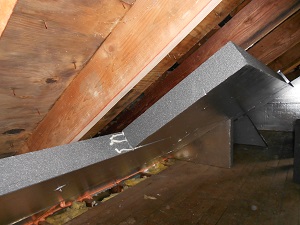Attic Insulation
Put an end to uncomfortable rooms and high utility bills with an affordable attic insulation upgrade
Larry Janesky, explains how the "stack effect" can make an uninsulated attic a huge source of energy loss.
Heat passes all too easily through a poorly insulated attic. In the winter, heated interior air rises naturally by convection and escapes into the attic through numerous air leaks. Conductive heat loss through the cold ceiling makes rooms directly beneath the attic even colder.
The problem reverses on a hot summer day, as attic temperatures rise to the 140 degree range and heat moves into your living space.
If you're worried about insufficient insulation in your home, get in touch with Foam Tech today!
7 signs of inadequate attic insulation
- Rooms directly beneath the attic get too hot or too cold at certain times of the year –even though other parts of the house remain comfortable.
- High electric bills and/or high bills for heating fuel.
- Cold drafts in certain parts of the house during wintertime.
- Recessed “can” lights in the ceiling directly below the attic.
- Attic floor joists are visible above or between existing attic insulation.
- Less than 10 in. of attic insulation.
- Attic ductwork is exposed above insulation layer.
Don’t let a common construction defect make your home uncomfortable and expensive to own.
Do it once, do it right & enjoy the benefits forever
- An attic insulation upgrade can cut your heating & cooling costs by as much as 40%.
- Restore comfort to rooms that get too hot or too cold at different times of the year.
- Make a once-and-done improvement that never wears out or requires maintenance.
- Improve your home’s green value.
Many houses have just 9 in. of attic insulation (about R-19) in regions where the U.S. Dept. of Energy recommends 16 in. (about R-60) of insulation. How did this happen?
For starters, local building codes only stipulate minimum performance standards, which are far below what home energy experts recognize as necessary today.
Insulation was often overlooked in an effort to cut costs or because cheap heating fuel made insulation all but unnecessary.
Regardless of what caused this construction defect, Foam tech has the cure: expert sealing of air leaks, followed by expertly installed new attic insulation.
Expert attic services from Foam Tech
- Free attic insulation & air sealing inspection.
- Free Estimates for all proposed insulation & air sealing upgrades.
- Blower door tests to measure air leakage and pinpoint leak locations.
- Access to the best insulation and air sealing materials.
- Expert installation of attic insulation by our trained technicians.
- Duct sealing and duct insulation for attic ductwork.
- Different attic insulation options, including cellulose, spray foam and the SuperAttic® system.
- Total home energy assessments to identify additional energy-saving opportunities.
Learn More About This >
Roof Insulation
Insulating the roof rather than the attic can be a smart option in some homes

The top of the house is always a top priority in any effort to improve home energy efficiency. On cold winter days, we need to prevent interior warmth from escaping into the attic.
On hot summer days, extra protection in the roof or attic can prevent super-hot roof temperatures from reaching your living space.
Roof insulation or attic insulation, along with air sealing, can prevent rooms from getting too hot or too cold at different times of the year, while also reducing your heating and cooling expenses. But when is roof insulation preferable to attic insulation?
Insulating the roof is the best strategy when your attic is full of stored items or HVAC equipment
Is a large part of your attic floor used as storage space? Does your attic contain HVAC equipment like air handlers and ductwork? Do you plan to convert your attic to living space in the future? If you answered “yes” to any of these questions, installing new insulation for the roof is a smart upgrade that will make your home more comfortable and less expensive to own.
Installing roof insulation brings your attic space within your home’s “building envelope,” the insulated shell that separates interior and exterior spaces. Instead of being cold in the winter or unpleasantly hot in the summer, a “conditioned” attic (an attic with roof insulation) will be at about the same temperature as the rest of your interior space.
Two innovative, super-effective roof insulation systems
 Spray foam insulation is applied between rafters (below). Only a small application is required because the foam expands to fill the space.
Spray foam insulation is applied between rafters (below). Only a small application is required because the foam expands to fill the space.
Foam Tech is a leader in innovative roof insulation systems. Depending on your home’s design, your budget and other factors, one of our roofing insulation systems ill give you the comfort and energy savings you’re aiming for.
Spray foam insulation. A complex roof (with numerous ridges and valleys), or a roof framed with trusses rather than individual rafters isn’t suitable for SuperAttic treatment. Instead, we can install insulation in the form of spray polyurethane foam (SPF). SPF is created by blending two liquid compounds at a special application nozzle. The mixture immediately begins to foam, expanding to fill the spaces between rafters and sticking tenaciously to everything in its path. After a few minutes, the high R-value foam hardens to form a permanent layer of insulation that won’t allow air or water to pass through it. We understand some insulation installations are more difficult than others, such as installing loft ceiling insulation, but our experts are trained to overcome even the toughest obstacles.

